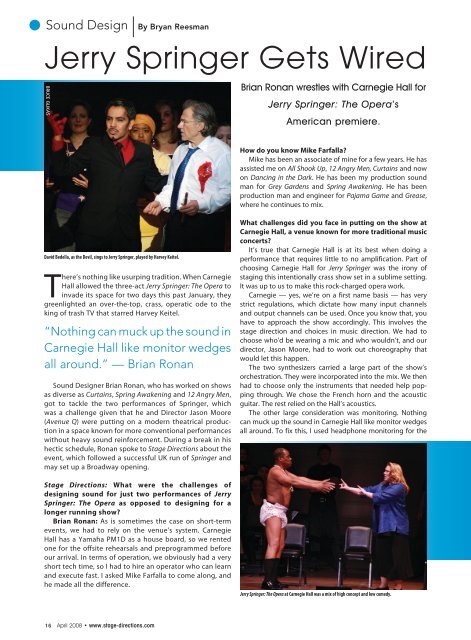Download a PDF - Stage Directions Magazine
Download a PDF - Stage Directions Magazine
Download a PDF - Stage Directions Magazine
You also want an ePaper? Increase the reach of your titles
YUMPU automatically turns print PDFs into web optimized ePapers that Google loves.
Sound Design<br />
By Bryan Reesman<br />
Jerry Springer Gets Wired<br />
Bruce Glikas<br />
Brian Ronan wrestles with Carnegie Hall for<br />
Jerry Springer: The Opera’s<br />
American premiere.<br />
How do you know Mike Farfalla?<br />
Mike has been an associate of mine for a few years. He has<br />
assisted me on All Shook Up, 12 Angry Men, Curtains and now<br />
on Dancing in the Dark. He has been my production sound<br />
man for Grey Gardens and Spring Awakening. He has been<br />
production man and engineer for Pajama Game and Grease,<br />
where he continues to mix.<br />
David Bedella, as the Devil, sings to Jerry Springer, played by Harvey Keitel.<br />
There’s nothing like usurping tradition. When Carnegie<br />
Hall allowed the three-act Jerry Springer: The Opera to<br />
invade its space for two days this past January, they<br />
greenlighted an over-the-top, crass, operatic ode to the<br />
king of trash TV that starred Harvey Keitel.<br />
“Nothing can muck up the sound in<br />
Carnegie Hall like monitor wedges<br />
all around.” — Brian Ronan<br />
Sound Designer Brian Ronan, who has worked on shows<br />
as diverse as Curtains, Spring Awakening and 12 Angry Men,<br />
got to tackle the two performances of Springer, which<br />
was a challenge given that he and Director Jason Moore<br />
(Avenue Q) were putting on a modern theatrical production<br />
in a space known for more conventional performances<br />
without heavy sound reinforcement. During a break in his<br />
hectic schedule, Ronan spoke to <strong>Stage</strong> <strong>Directions</strong> about the<br />
event, which followed a successful UK run of Springer and<br />
may set up a Broadway opening.<br />
<strong>Stage</strong> <strong>Directions</strong>: What were the challenges of<br />
designing sound for just two performances of Jerry<br />
Springer: The Opera as opposed to designing for a<br />
longer running show?<br />
Brian Ronan: As is sometimes the case on short-term<br />
events, we had to rely on the venue’s system. Carnegie<br />
Hall has a Yamaha PM1D as a house board, so we rented<br />
one for the offsite rehearsals and preprogrammed before<br />
our arrival. In terms of operation, we obviously had a very<br />
short tech time, so I had to hire an operator who can learn<br />
and execute fast. I asked Mike Farfalla to come along, and<br />
he made all the difference.<br />
What challenges did you face in putting on the show at<br />
Carnegie Hall, a venue known for more traditional music<br />
concerts?<br />
It’s true that Carnegie Hall is at its best when doing a<br />
performance that requires little to no amplification. Part of<br />
choosing Carnegie Hall for Jerry Springer was the irony of<br />
staging this intentionally crass show set in a sublime setting.<br />
It was up to us to make this rock-charged opera work.<br />
Carnegie — yes, we’re on a first name basis — has very<br />
strict regulations, which dictate how many input channels<br />
and output channels can be used. Once you know that, you<br />
have to approach the show accordingly. This involves the<br />
stage direction and choices in music direction. We had to<br />
choose who’d be wearing a mic and who wouldn’t, and our<br />
director, Jason Moore, had to work out choreography that<br />
would let this happen.<br />
The two synthesizers carried a large part of the show’s<br />
orchestration. They were incorporated into the mix. We then<br />
had to choose only the instruments that needed help popping<br />
through. We chose the French horn and the acoustic<br />
guitar. The rest relied on the Hall’s acoustics.<br />
The other large consideration was monitoring. Nothing<br />
can muck up the sound in Carnegie Hall like monitor wedges<br />
all around. To fix this, I used headphone monitoring for the<br />
Jerry Springer: The Opera at Carnegie Hall was a mix of high concept and low comedy.<br />
16 April 2008 • www.stage-directions.com

















